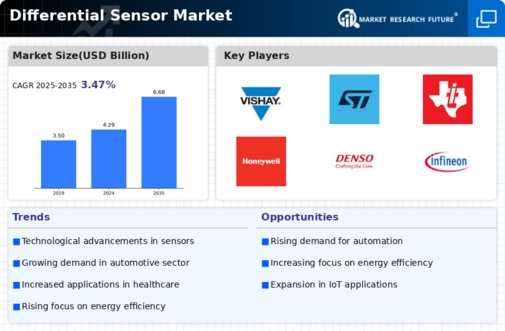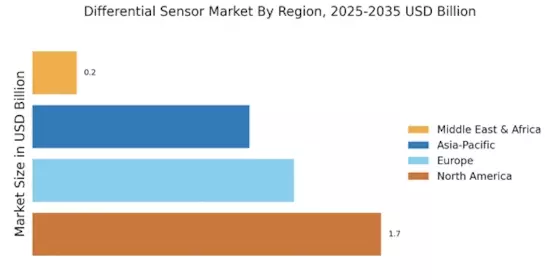Rising Demand for Automation
The increasing demand for automation across various industries appears to be a primary driver for the Differential Sensor Market. As manufacturing processes become more automated, the need for precise measurement and control systems intensifies. Differential sensors play a crucial role in providing accurate data for monitoring and controlling processes, thereby enhancing efficiency and reducing operational costs. According to recent estimates, the automation sector is projected to grow at a compound annual growth rate of approximately 9% over the next few years. This growth is likely to propel the demand for differential sensors, as industries seek to optimize their operations and improve product quality. Consequently, the Differential Sensor Market is expected to witness substantial growth as companies invest in advanced sensor technologies to meet the evolving demands of automation.
Growth in Renewable Energy Sector
The renewable energy sector's growth is emerging as a significant driver for the Differential Sensor Market. As the world shifts towards sustainable energy sources, the demand for efficient monitoring and control systems in wind, solar, and hydroelectric power generation is increasing. Differential sensors are essential for measuring pressure differentials in various applications, including fluid dynamics in turbines and solar thermal systems. The renewable energy market is anticipated to grow at a rate of approximately 8% per year, reflecting a global commitment to reducing carbon emissions. This growth is likely to create new opportunities for the Differential Sensor Market, as companies seek advanced sensor technologies to optimize energy production and ensure system reliability.
Increased Focus on Safety Standards
The heightened focus on safety standards across industries is driving the Differential Sensor Market. Regulatory bodies are implementing stricter safety regulations, necessitating the use of advanced sensor technologies to monitor critical parameters. Differential sensors are vital for ensuring compliance with safety standards in sectors such as oil and gas, chemicals, and pharmaceuticals. The market for safety compliance technologies is projected to grow at a rate of around 7% annually, as companies prioritize safety and risk management. This trend indicates that the Differential Sensor Market will likely expand as organizations invest in reliable sensor solutions to meet regulatory requirements and enhance operational safety.
Expansion of Automotive Applications
The automotive sector's expansion is significantly influencing the Differential Sensor Market. With the rise of electric vehicles and advanced driver-assistance systems, the need for accurate pressure and fluid level measurements has become paramount. Differential sensors are increasingly utilized in automotive applications to monitor critical parameters, ensuring safety and performance. The automotive industry is projected to experience a growth rate of around 6% annually, driven by innovations in vehicle technology and increasing consumer demand for safety features. This trend suggests that the Differential Sensor Market will benefit from the automotive sector's growth, as manufacturers seek reliable and efficient sensor solutions to enhance vehicle performance and safety.
Technological Innovations in Sensor Design
Technological innovations in sensor design are significantly impacting the Differential Sensor Market. Advances in materials science and microfabrication techniques are leading to the development of more compact, accurate, and cost-effective differential sensors. These innovations enable the integration of sensors into a wider range of applications, from industrial automation to consumer electronics. The sensor technology market is expected to grow at a compound annual growth rate of approximately 10%, driven by the demand for smarter and more efficient devices. This growth suggests that the Differential Sensor Market will benefit from ongoing technological advancements, as manufacturers seek to leverage new sensor capabilities to enhance product performance and functionality.

















Leave a Comment